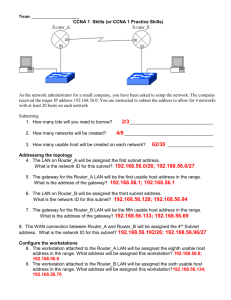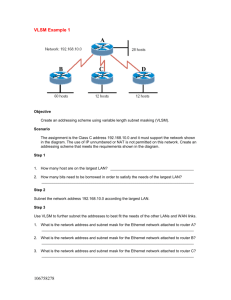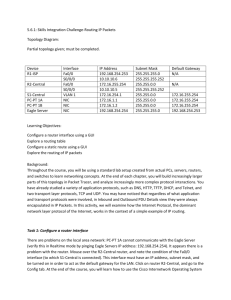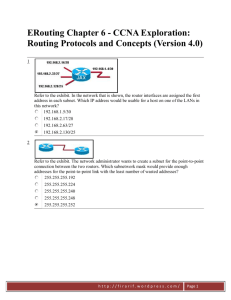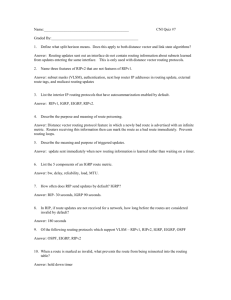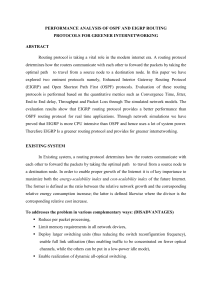1 - ap13blog
advertisement
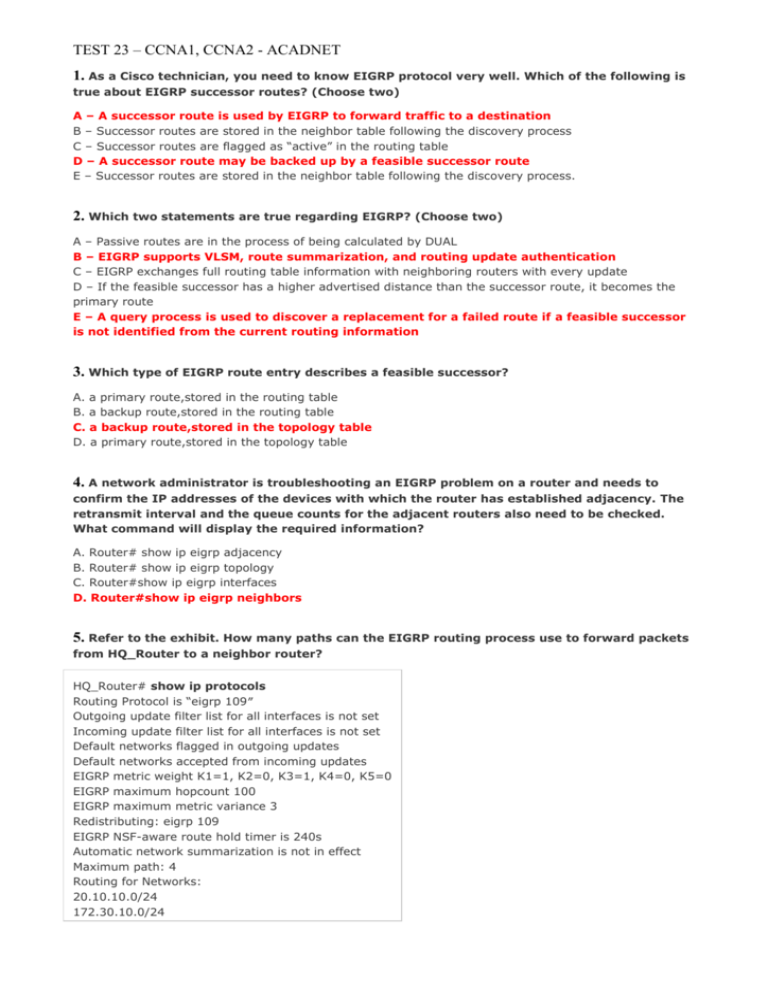
TEST 23 – CCNA1, CCNA2 - ACADNET 1. As a Cisco technician, you need to know EIGRP protocol very well. Which of the following is true about EIGRP successor routes? (Choose two) A – A successor route is used by EIGRP to forward traffic to a destination B – Successor routes are stored in the neighbor table following the discovery process C – Successor routes are flagged as “active” in the routing table D – A successor route may be backed up by a feasible successor route E – Successor routes are stored in the neighbor table following the discovery process. 2. Which two statements are true regarding EIGRP? (Choose two) A – Passive routes are in the process of being calculated by DUAL B – EIGRP supports VLSM, route summarization, and routing update authentication C – EIGRP exchanges full routing table information with neighboring routers with every update D – If the feasible successor has a higher advertised distance than the successor route, it becomes the primary route E – A query process is used to discover a replacement for a failed route if a feasible successor is not identified from the current routing information 3. Which type of EIGRP route entry describes a feasible successor? A. a primary route,stored in the routing table B. a backup route,stored in the routing table C. a backup route,stored in the topology table D. a primary route,stored in the topology table 4. A network administrator is troubleshooting an EIGRP problem on a router and needs to confirm the IP addresses of the devices with which the router has established adjacency. The retransmit interval and the queue counts for the adjacent routers also need to be checked. What command will display the required information? A. Router# show ip eigrp adjacency B. Router# show ip eigrp topology C. Router#show ip eigrp interfaces D. Router#show ip eigrp neighbors 5. Refer to the exhibit. How many paths can the EIGRP routing process use to forward packets from HQ_Router to a neighbor router? HQ_Router# show ip protocols Routing Protocol is “eigrp 109″ Outgoing update filter list for all interfaces is not set Incoming update filter list for all interfaces is not set Default networks flagged in outgoing updates Default networks accepted from incoming updates EIGRP metric weight K1=1, K2=0, K3=1, K4=0, K5=0 EIGRP maximum hopcount 100 EIGRP maximum metric variance 3 Redistributing: eigrp 109 EIGRP NSF-aware route hold timer is 240s Automatic network summarization is not in effect Maximum path: 4 Routing for Networks: 20.10.10.0/24 172.30.10.0/24 TEST 23 – CCNA1, CCNA2 - ACADNET 192.168.1.0 Routing Information Sources: Gateway Distance Last Update 20.10.10.2 90 00:13:12 172.30.10.2 90 01:13:06 Distance: internal 90 external 170 HQ_Router# A. two equal-cost paths B. two unequal-cost paths C. three equal-cost paths D. three unequal-cost paths E. four equal-cost paths F. four unequal-cost paths 6. IP address and routing for the network are configured as shown in the exhibit. The network administrator issues the show ip eigrp neighbors command from Router1 and receives the output shown below the topology. Which statement is true? A. It is normal for Router1 to show one active neighbor at a time to prevent routing loops. B. Routing is not completely configured on Router3. C. The IP addresses are not configured properly on the Router1 and Router3 interfaces. D. The no auto-summary command configured on the routers prevents Router1 and Router2 from forming a neighbor relationship. 7. A router has learned three possible routes that could be used to reach a destination network. One route is from EIGRP and has a composite metric of 20514560. Another route is from OSPF with a metric of 782. The last is from RIPv2 and has a metric of 4. Which route or routes will the router install in the routing table? A. the OSPF route B. the EIGRP route TEST 23 – CCNA1, CCNA2 - ACADNET C. the RIPv2 route D. all three routes E. the OSPF and RIPv2 routes 8. Refer to the exhibit. Based on the exhibited routing table, how will packets from a host within the 192.168.10.192/26 LAN be forwarded to 192.168.10.1? A. The router will forward packets from R3 to R2 to R1 B. The router will forward packets from R3 to R1 C. The router will forward packets from R3 to R1 to R2 D. The router will forward packets from R3 to R2 to R1 AND from R3 to R1 9. Refer to the exhibit. The company uses EIGRP as the routing protocol. What path will packets take from a host on 192.168.10.192/26 network to a host on the LAN attached to router R1? TEST 23 – CCNA1, CCNA2 - ACADNET R3# show ip route Gateway of last resort is not set 192 168.10.0/24 is variably subnetted, 6 subnets, 2 masks D 192.168.10.64/26 [90/2195456] via 192.168.10.9, 00:03:31, Serial0/0 D 192.168.10.0/30 [90/2681856] via 192.168.10.9, 00:03:31, Serial0/0 C 192.168.10.4/30 is directly connected, Serial0/1 C 192.168.10.8/30 is directly connected, Serial0/0 C 192.168.10.192/26 is directly connected, FastEthernet0/0 D 192.168.10.128/26 [90/2195456] via 192.168.10.5,00:03:31, Serial0/1 A. The path of the packets will be R3 to R2 to R1. B. The path of the packets will be R3 to R1 to R2. C. The path of the packets will be both R3 to R2 to R1 and R3 to R1. D. The path of the packets will be R3 to R1 10. Refer to the exhibit. A packet with a source IP address of 192.168.2.4 and a destination IP address of 10.1.1.4 arrives at the HokesB router. What action does the router take? A. forwards the received packet out the Serial0/0 interface B. forwards a packet containing an EIGRP advertisement out the Serial0/1 interface TEST 23 – CCNA1, CCNA2 - ACADNET C. forwards a packet containing an ICMP message out the FastEthemet0/0 interface D. forwards a packet containing an ARP request out the FastEthemet0/1 interface Explanation 11. When a packet with destination IP address of 10.1.1.4 arrives at HokesB, it will look up in the routing table to find the most specific path. In this case no path is found so HokesB must inform to the source host that the destination is unreachable on the interface it has received this packet (it is Fa0/0 because the network 192.168.2.0/28 is learned from this interface). The EIGRP configuration in the Glencoe router uses a single network statement. From the output shown in the graph would advertise these networks in EIGRP? A. network 172.26.168.0 area 478 B. network 172.26.0.0 C. network 172.26.168.128 0.0.0.127 D. network 172.26.168.128 area 478 12. Given a subnet mask of 255.255.255.224, which of the following addresses can be assigned to network hosts? (Choose three) A – 15.234.118.63 B – 92.11.178.93 C – 134.178.18.56 D – 192.168.16.87 E – 201.45.116.159 F – 217.63.12.192 13. Which of the following host addresses are members of networks that can be routed across the public Internet? (Choose three) A – 10.172.13.65 B – 172.16.223.125 C – 172.64.12.29 D – 192.168.23.252 E – 198.234.12.95 F – 212.193.48.254 14. A national retail chain needs to design an IP addressing scheme to support a nationwide network. The company needs a minimum of 300 sub-networks and a maximum of 50 host TEST 23 – CCNA1, CCNA2 - ACADNET addresses per subnet. Working with only one Class B address, which of the following subnet masks will support an appropriate addressing scheme? (Choose two) A – 255.255.255.0 B – 255.255.255.128 C – 255.255.252.0 D – 255.255.255.224 E – 255.255.255.192 F – 255.255.248.0 15. Which of the following IP addresses fall into the CIDR block of 115.64.4.0/22? (Choose three) A – 115.64.8.32 B – 115.64.7.64 C – 115.64.6.255 D – 115.64.3.255 E – 115.64.5.128 F – 115.64.12.128 16. The network 172.25.0.0 has been divided into eight equal subnets. Which of the following IP addresses can be assigned to hosts in the third subnet if the ip subnet-zero command is configured on the router? (Choose three) A – 172.25.78.243 B – 172.25.98.16 C – 172.25.72.0 D – 172.25.94.255 E – 172.25.96.17 F. 172.25.100.16 Explanation If the “ip subnet-zero” command is configured then the first subnet is 172.25.0.0. Otherwise the first subnet will be 172.25.32.0 (we will learn how to get 32 below). The question stated that the network 172.25.0.0 is divided into eight equal subnets therefore the increment is 256 / 8 = 32 and its corresponding subnet mask is /19 (1111 1111.1111 1111.1110 0000). First subnet: 172.25.0.0/19 Second subnet: 172.25.32.0/19 Third subnet: 172.25.64.0/19 4th subnet: 172.25.96.0/19 5th subnet: 172.25.128.0/19 6th subnet: 172.25.160.0/19 7th subnet: 172.25.192.0/19 8th subnet: 172.25.224.0/19 In fact, we only need to specify the third subnet as the question requested. The third subnet ranges from 172.25.64.0/19 to 172.25.95.255/19 17. Refer to the exhibit. In this VLSM addressing scheme, what summary address would be sent from router A? TEST 23 – CCNA1, CCNA2 - ACADNET A. 172.16.0.0/16 B. 172.16.0.0/20 C. 172.16.0.0/24 D. 172.32.0.0/16 E. 172.32.0.0/17 F. 172.64.0.0/16 18. Refer to the exhibit. Which VLSM mask will allow for the appropriate number of host addresses for Network A? A. /25 B. /26 C. /27 D. /28 19. Refer to the exhibit. Which subnet mask will place all hosts on Network B in the same subnet with the least amount of wasted addresses? A. 255.255.255.0 B. 255.255.254.0 TEST 23 – CCNA1, CCNA2 - ACADNET C. 255.255.252.0 D. 255.255.248.0 20. Refer to the exhibit. Which mask is correct to use for the WAN link between the routers that will provide connectivity while wasting the least amount of addresses? A. /23 B. /24 C. /25 D. /30 21. Refer to the exhibit. What is the most appropriate summarization for these routes? A. 10.0.0.0/21 B. 10.0.0.0/22 C. 10.0.0.0/23 D. 10.0.0.0/24 22. On the network 131.1.123.0/27, what is the last IP address that can be assigned to a host? A. 131.1.123.30 B. 131.1.123.31 C. 131.1.123.32 D. 131.1.123.33 23. The ip subnet zero command is not configured on a router. What would be the IP address of Ethernet0/0 using the first available address from the sixth subnet of the network 192.168.8.0/29? A. 192.168.8.25 B. 192.168.8.41 C. 192.168.8.49 D. 192.168.8.113 Explanation The “ip subnet zero” is not configured so the first subnet will start at 192.168.8.8 (ignoring 192.168.8.0). Increment: 8 1st subnet: 192.168.8.8 2nd subnet: 192.168.8.16 3rd subnet: 192.168.8.24 TEST 23 – CCNA1, CCNA2 - ACADNET 4th subnet: 192.168.8.32 5th subnet: 192.168.8.40 6th subnet: 192.168.8.48 -> The first usable IP address of 6th subnet is 192.168.8.49 24. For the network 192.0.2.0/23, which option is a valid IP address that can be assigned to a host? A. 192.0.2.0 B. 192.0.2.255 C. 192.0.3.255 D. 192.0.4.0 25. How many addresses for hosts will the network 124.12.4.0/22 provide? A. 510 B. 1022 C. 1024 D. 2048 26. The network default gateway applying to a host by DHCP is 192.168.5.33/28. Which option is the valid IP address of this host? A. 192.168.5.55 B. 192.168.5.47 C. 192.168.5.40 D. 192.168.5.32 E. 192.168.5.14 27. Which two addresses can be assigned to a host with a subnet mask of 255.255.254.0? (Choose two) A. 113.10.4.0 B. 186.54.3.0 C. 175.33.3.255 D. 26.35.2.255 E. 17.35.36.0 28. Workstation A has been assigned an IP address of 192.0.2.24/28. Workstation B has been assigned an IP address of 192.0.2.100/28. The two workstations are connected with a straight-through cable. Attempts to ping between the hosts are unsuccessful. What two things can be done to allow communications between the hosts? (Choose two) A. Replace the straight-through cable with a crossover cable. B. Change the subnet mask of the hosts to /25. C. Change the subnet mask of the hosts to /26. D. Change the address of Workstation A to 192.0.2.15. E. Change the address of Workstation B to 192.0.2.111. Explanation With the subnet mask of /28, 192.0.2.24 & 192.0.2.100 will be in different subnets (192.0.2.24 belongs to subnet 192.0.2.16/28; 192.0.2.100 belongs to subnet 192.0.2.96). To make them in the same subnet we need more space for host. Because 100 < 128 so we the suitable subnet should be /25. 29. Your ISP has given you the address 223.5.14.6/29 to assign to your router’s interface. They have also given you the default gateway address of 223.5.14.7. After you have TEST 23 – CCNA1, CCNA2 - ACADNET configured the address, the router is unable to ping any remote devices. What is preventing the router from pinging remote devices? A. The default gateway is not an address on this subnet. B. The default gateway is the broadcast address for this subnet. C. The IP address is the broadcast address for this subnet. D. The IP address is an invalid class D multicast address. 30. Refer to the exhibit. According to the routing table, where will the router send a packet destined for 10.1.5.65? Network Interface Next-hop 10.1.1.0/24 e0 directly connected 10.1.2.0/24 e1 directly connected 10.1.3.0/25 s0 directly connected 10.1.4.0/24 s1 directly connected 10.1.5.0/24 e0 10.1.1.2 10.1.5.64/28 e1 10.1.2.2 10.1.5.64/29 s0 10.1.3.3 10.1.5.64/27 s1 10.1.4.4 A. 10.1.1.2 B. 10.1.2.2 C. 10.1.3.3 D. 10.1.4.4 31. A network interface port has collision detection and carrier sensing enabled on a shared twisted pair network. From this statement, what is known about the network interface port? A. This is a 10 Mb/s switch port. B. This is a 100 Mb/s switch port. C. This is an Ethernet port operating at half duplex. D. This is an Ethernet port operating at full duplex. E. This is a port on a network interface card in a PC. 32. Which routing protocol by default uses bandwidth and delay as metrics? A. RIP B. BGP C. OSPF D. EIGRP 33. On a network of one department, there are four PCs connected to a switch, as shown in the following figure: TEST 23 – CCNA1, CCNA2 - ACADNET After the Switch1 restarts. Host A ( the host on the left ) sends the first frame to Host C (the host on the right). What the first thing should the switch do? A. Switch1 will add 192.168.23.12 to the switching table. B. Switch1 will add 192.168.23.4 to the switching table. C. Switch1 will add 000A.8A47.E612 to the switching table. D. None of the above 34. If the subnet mask is 255.255.255.224, which of the following addresses can be assigned to network hosts? (Choose three) A – 15.234.118.63 B – 92.11.178.93 C – 134.178.18.56 D – 192.168.16.87 35. An administrator issues the command “ping 127.0.0.1″ from the command line prompt on a PC host named PC1. If an ICMP reply is received, what does this confirm? A – The PC host PC1 has connectivity with a local host B – The PC host PC1 has connectivity with a Layer 3 device C – The PC host PC1 has a default gateway correctly configured D – The PC host PC1 has connectivity up to Layer 5 of the OSI model E – The PC host PC1 has the TCP/IP protocol stack correctly installed 36. Study the exhibit carefully, can you tell which three description are correct about the ways used by the router R1 to choose a path to the 10.1.3.0/24 network when different routing protocols are deployed? (Choose three) TEST 23 – CCNA1, CCNA2 - ACADNET A – When RIPv2 is the routing protocol, only the path R1-R4 is to be installed into the routing table by default B – When RIPv2 is the routing protocol, the equal cost paths R1-R3-R4 and R1-R2-R4 are to be installed in the routing table C – If both EIGRP and OSPF are working on the network with their default configurations, the EIGRP paths will be installed in the routing table D – By default, if EIGRP is the routing protocol, the equal cost paths R1-R3-R4 and R1-R2-R4 will be installed in the routing table 37. Which two devices can interfere with the operation of a wireless network because they operate on similar frequencies? (Choose two) A. copier B. microwave oven C. toaster D. cordless phone E. IP phone F. AM radio 38. What is the maximum data rate specified for IEEE 802.11b WLANs? A. 10 Mbps B. 11 Mbps C. 54 Mbps D. 100 Mbps 39. Which of the following are true regarding passwords on a Cisco router?(Choose four) a) All passwords can be encrypted b) All passwords can be entered using the set-up dialogue c) A password can be set before a user can enter the privileged mode d) A password can be set for individual lines e) TACACS or Radius password authentication can be used. Explicatie: Terminal Access Controller Access-Control System (TACACS) is a remote authentication protocol that is used to communicate with an authentication server commonly used inUNIX networks. TACACS allows a remote access server to communicate with an authentication server in order to determine if the user has access to the network. TACACS is defined in RFC 1492, and uses (either TCP or UDP) port 49 by default. A TEST 23 – CCNA1, CCNA2 - ACADNET later version of TACACS introduced by Cisco in 1990 was called Extended TACACS (XTACACS). The XTACACS protocol was developed by and is proprietary to Cisco Systems. Remote Authentication Dial In User Service (RADIUS) is a networking protocol that provides centralized Authentication, Authorization, and Accounting (AAA) management for computers to connect and use a network service. RADIUS was developed by Livingston Enterprises, Inc., in 1991 as an access server authentication and accounting protocol and later brought into the Internet Engineering Task Force (IETF) standards. Because of the broad support and the ubiquitous nature of the RADIUS protocol, it is often used by ISPs and enterprises to manage access to the Internet or internal networks, wireless networks, and integrated e-mail services. These networks may incorporatemodems, DSL, access points, VPNs, network ports, web servers, etc. RADIUS is a client/server protocol that runs in the application layer, using UDP as transport. The Remote Access Server, the Virtual Private Network server, the Network switch with port-based authentication, and the Network Access Server (NAS), are all gateways that control access to the network, and all have a RADIUS client component that communicates with the RADIUS server. The RADIUS server is usually a background process running on a UNIX or Microsoft Windows server. RADIUS serves three functions: 1. to authenticate users or devices before granting them access to a network, 2. to authorize those users or devices for certain network services and 3. to account for usage of those services. 40. Which of the following is true of ISDN(Integrated Services Digital Network )? (choose two) a) Carries voice only b) Carries data only c) Carries voice and data d) Can be used for World Wide Web (WWW) Explicatie: Integrated services refers to ISDN's ability to deliver at minimum two simultaneous connections, in any combination of data, voice, video, and fax, over a single line. Multiple devices can be attached to the line, and used as needed. That means an ISDN line can take care of most people's complete communications needs (apart from broadband Internet accessand entertainment television) at a much higher transmission rate, without forcing the purchase of multiple analog phone lines. It also refers to integrated switching and transmission in that telephone switching and carrier wave transmission are integrated rather than separate as in earlier technology. 41. NVRAM is best described as: a) A location to run the active configuration from b) A location to run the power on diagnostics from c) A location to store a backup copy of the router configuration file d) The source of commonly used configuration commands e) The primary source of the Cisco IOS 42. Select all the characteristics of a Distance Vector routing protocol (Choose two). a) All routers construct an overall view of the internetwork from their perspective. b) Routers broadcast their routing table at periodic intervals. c) Routers broadcast only the changes to the internetwork that they have become aware of. d) Routers discover the best path to destination networks based on accumulated metrics from each neighbor. e) During the initial discovery, all routers send LSPs to all other routers. f) Updates to the routing tables are usually triggered by topology changes. 43. Which of the following protocols is unacknowledged? TEST 23 – CCNA1, CCNA2 - ACADNET a. TCP b. SPX c.Telnet d. UDP e. FTP 44. In order to communicate throughout an internetwork, which of the following are required (Choose two). a) The use of a routable protocol such as NetBEUI or LAT b) A hierarchical naming scheme server such as DNS c) A host file at each communicating device d) A two part network addressing scheme such as Network/Host e) The use of a routable protocol such as IP or IPX f) The use of a routable protocol such as TCP or IPX 45. What is the default route on an IP network? a. This is the route that will be chosen first by IP for delivery of a datagram. b. The address of the nearest downstream neighbor in a Token ring network. c. At the router, it is the route used to direct frames for which the next hop has not been explicitly listed in the routing table. d.Any static route listing in a routing table. e. When all conditions are equal, the best route for delivery of IP datagrams. 46. Which of the following are benefits of a Link-State routing protocol? (Choose all that apply.) a) Allows the use of a more robust addressing scheme b) Allows for a larger scalable network c) Reduces convergence time d) Allows "supernetting" 47. On an IP over Token Ring network, which answer best describes the role of ARP? a. ARP is used to map an IP address to a MAC address b.ARP is used to map Ring numbers to IP addresses c. ARP is used to map Ring numbers to MAC addresses of the hosts on that ring d. ARP is used to map a MAC address to an IP address e. ARP is not used on Token Ring networks 48. How many subnets are possible with a Class B address and a subnet mask of 255.255.255.128? a. 255 b. 256 c. 254 TEST 23 – CCNA1, CCNA2 - ACADNET d. 512 e. 510 49. Which three addresses are private IP addresses? (Choose three.) a. 10.0.0.1 b. 46.1.1.88 c. 172.31.31.10 d. 172.32.16.10 e. 192.168.8.8 50. What is the effect of using the Router# copy running-config startup-config command on a router? a.The contents of ROM will change. b. The contents of RAM will change. c. The contents of NVRAM will change. d. The contents of flash will change.

